Stalin’s victory? The Soviet Union and World War II
Published in 20th-century / Contemporary History, Features, Issue 1 (Jan/Feb 2008), Volume 16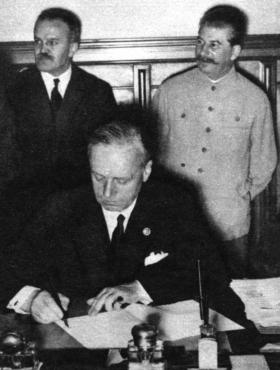
Ribbontrop, the German foreign minister, signing the Nazi–Soviet pact on 23 August 1939. Soviet foreign minister Molotov and Stalin stand in the background. (Interfoto)
When World War II ended in 1945 few doubted that the victor’s laurels belonged mainly to Joseph Stalin. Under his leadership the Soviet Union had just won the war of the century, and that victory was closely identified with his role as the country’s supreme commander.
World War II was a global conflict of immense proportions in which 50 million people died, but at its heart was the epic struggle between Stalin and Hitler on the Eastern Front. The war began with Hitler’s attack on Poland in September 1939 and was followed by the stunning German defeat of France in summer 1940. Not until June 1941 did Hitler launch his invasion of the Soviet Union—a state that posed a strategic threat to German domination of Europe as well as being an ideological rival and racial enemy.
At first all went well for Operation Barbarossa—the codename for the German invasion—as Hitler’s armies penetrated deep into Russia, reaching the outskirts of Leningrad and Moscow by the end of 1941. In 1942, however, the Soviets turned the tables on the Germans and won a great victory at Stalingrad that spelled doom for the Wehrmacht. In 1943 and 1944 the Red Army expelled the Germans from the rest of Russia and then began an invasion of Germany that culminated in the capture of Berlin in May 1945.
Eighty per cent of combat on the Eastern Front
Eighty per cent of all the combat of World War II took place on the Eastern Front. During the four years of the Soviet–German struggle the Red Army destroyed 600 enemy divisions (Italian, Hungarian, Romanian, Finnish, Croat, Slovak and Spanish as well as German). The Germans suffered ten million casualties (75% of their total wartime losses), including three million dead, while Hitler’s Axis allies lost another million. The Red Army destroyed 48,000 enemy tanks, 167,000 guns and 77,000 aircraft. In comparison, the contribution of Stalin’s western allies to the defeat of Germany was of secondary importance. Even after the Anglo-American invasion of France in June 1944 there were still twice as many German soldiers serving on the Eastern Front as in the West. On the other hand, Britain and the United States did supply a huge quantity of material aid to the USSR that greatly facilitated the Soviet victory over Germany.
Even so, victory did not come cheap. Red Army casualties totalled sixteen million, including eight million dead (three million in German POW camps). Adding to the attrition was the death of sixteen million Soviet civilians. Among these were a million Soviet Jews, executed by the Germans in 1941–2 at the beginning of the Holocaust. Material damage to the Soviet Union was equally staggering: six million houses, 98,000 farms, 32,000 factories, 82,000 schools, 43,000 libraries, 6,000 hospitals, and thousands of miles of roads and railways were destroyed. In total, the Soviet Union lost 25% of its national wealth and 14% of its population as a direct result of the war.
When the Red Army captured Berlin, the full extent of Soviet war damage was far from clear, but there was no doubt that the Soviets had fought a brutal war against a barbaric enemy and that the cost had been astronomical. Some saw the Soviet victory as pyrrhic—a victory won at too great a cost. Others worried that German domination of Europe had been replaced by a Soviet and communist threat to the continent. But for most people in the allied world, Stalin’s victory—whatever the costs and problems it brought—was preferable to Hitler’s dream of a global racist empire. Stalin was widely seen as Europe’s saviour from this fate, and when in June 1945 he was proclaimed ‘generalissimus’—the superlative general—it seemed only appropriate.
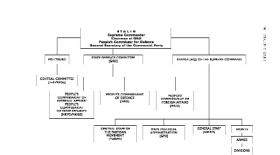
The structure of Soviet military and political decision-making during the Great Patriotic War.
Stalin at war
Stalin shared the military glory with his generals—above all with his deputy supreme commander, Marshal Georgi Zhukov—but Stalin’s role was political and economic as well as military. As supreme commander Stalin decided on military strategy and supervised all the big battles and operations. As People’s Commissar for Defence and chairman of the State Defence Council he was responsible for the country’s mobilisation for total war. As head of government Stalin represented the USSR at summit meetings with its British and American allies and corresponded on a regular basis with Winston Churchill and President Franklin Delano Roosevelt. As leader of the Communist Party it fell to him to rally the Soviet people for a patriotic war of national defence. (See diagram, p. 43.)
Stalin’s public image was that of a benign dictator, and hopes were high that his regime would evolve into a more liberal and democratic state. But it was no secret that he was a ruthless dictator who presided over an authoritarian communist state that terrorised its own people. During the war the harshest discipline was imposed, and Stalin brooked no wavering in the face of the enemy: some 170,000 Soviet military personnel were executed for treason, cowardice or ill discipline. Whole communities and ethnic groups, accused of collective collaboration with the enemy, were uprooted and deported. At the end of the war millions of returning Soviet POWS were screened for disloyalty, and a quarter of a million of them were executed or re-imprisoned. Needless to say, there was no mercy for the million Soviet citizens who had fought on the German side.
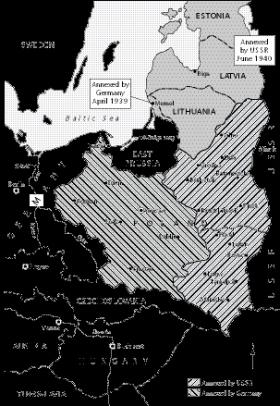
The Nazi–Soviet non-aggression pact, August–September 1939.
At the time much of this repression remained hidden, and public attention focused on Stalin’s image as a highly successful and very effective war leader. The contemporary impression was summed up by one of his earliest biographers, Isaac Deutscher, writing in 1948:
‘Many allied visitors who called at the Kremlin during the war were astonished to see on how many issues, great and small, military, political or diplomatic, Stalin took the final decision. He was in effect his own commander-in-chief, his own minister of defence, his own quartermaster, his own minister of supply, his own foreign minister, and even his own chef de protocol . . . Thus he went on, day after day, throughout four years of hostilities—a prodigy of patience, tenacity, and vigilance, almost omnipresent, almost omniscient.’
The Nazi–Soviet pact
But Stalin’s reputation soon began to take a battering. When the wartime grand alliance with Britain and the United States gave way to the Cold War in 1947 the Soviet role in the Second World War was criticised by western propagandists. A particular target was the Nazi–Soviet non-aggression pact of 1939–41. This was a deal between Stalin and Hitler that gave the German dictator a free hand to attack Poland and to fight the British and French. In return for a promise of Soviet neutrality Stalin was given a sphere of influence in Eastern Europe, including territory in Poland. In accordance with this agreement the Soviets invaded Eastern Poland on 17 September 1939 and occupied the territory allocated to them by the pact. (See map, p. 43.)
From the Soviet point of view, the invasion was justified by the fact that this territory had been forcibly occupied by the Poles in the wake of the Russo-Polish war of 1919–20. The territory’s inhabitants were mainly Ukrainian and Belorussian, and its reincorporation into the USSR meant the reunification of Eastern and Western Ukraine and Belorussia. But the Red Army’s invasion was clearly an act of aggression and the process of integrating Western Belorussia and Western Ukraine into the USSR was very violent, including the deportation of 400,000 ethnic Poles to the Soviet interior. Among their number were 20,000 Polish army officers and police officials, executed on Stalin’s orders in March–April 1940.
Britain went to war with Germany in defence of Poland, but the Soviet occupation of Eastern Poland was actually welcomed by Winston Churchill in a radio broadcast on 1 October 1939:
‘Russia has pursued a cold policy of self-interest. We could have wished that the Russian armies should be standing on their present line as the friends and allies of Poland instead of as invaders. But that the Russian armies should stand on this line was clearly necessary for the safety of Russia against the Nazi menace. I cannot forecast to you the action of Russia. It is a riddle wrapped in a mystery inside an enigma; but perhaps there is a key. That key is Russian national interest. It cannot be in accordance with the interests or the safety of Russia that Germany should plant itself upon the shores of the Black Sea, or that it should overrun the Balkan states and subjugate the Slavonic peoples of south-eastern Europe. That would be contrary to the historic life-interests of Russia.’
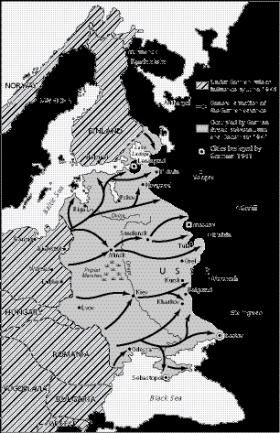
Operation Barbarossa, June–December 1941.
Consistency was never Churchill’s strong point, and a few weeks later he was urging Anglo-French intervention in the Soviet war with Finland. This conflict had broken out at the end of November 1939 when the Finns resisted Stalin’s demands to join a Soviet-led bloc in the Baltic. Churchill was willing to risk war with Russia because the real purpose of the Anglo-French expedition to Finland was to cut off Germany’s supplies of iron ore from Norway and Sweden. Faced with the escalation of their local war into a major conflict in Scandinavia, Stalin and the Finns agreed a peace treaty in March 1940. Finland was forced to make various territorial concessions to the Soviets but the country retained its independence.
Eventually Churchill was proved right: Stalin’s resistance to German domination of Europe prompted Hitler to invade the Soviet Union in 1941. But in 1939–40 Stalin was intent on cooperating as much as he could with Hitler, and the Nazi–Soviet pact was followed by a period of close political, economic and military cooperation between the two states. Stalin hoped that this collaboration would last a long time—long enough for him to prepare the country’s defences against a possible German attack. Stalin saw war with Hitler as possible, even likely, but not inevitable.
Stalin’s hopes for a durable deal with Hitler were not dented until the convening of a Soviet–German conference in Berlin in November 1940. Stalin was represented by his foreign minister, Vyacheslav Molotov, who was instructed to secure a new Nazi–Soviet pact that would guarantee the Soviet Union against German attack and extend Soviet–German spheres of influence arrangements to the Balkans. Hitler’s counter-offer of a subordinate role in a German-led coalition of Germany, Italy, Japan and the Soviet Union was unacceptable to Stalin, who responded by reiterating the need for a new Nazi–Soviet pact. Hitler ignored this proposal and on 18 December 1940 issued the order for Operation Barbarossa.
From January 1941 it was clear that a German–Soviet war was coming. Diplomatic relations between the two countries continued to deteriorate; there was a massive build-up of German military might along Soviet borders, and multiple sources of intelligence information indicated that the Germans were preparing an invasion. Stalin believed that to avoid a two-front war Hitler would not invade before he had defeated Britain. He was also persuaded that the German military–political élite was split on the question of attacking the Soviet Union and that some adroit diplomacy could still avert war. Above all, Stalin was confident that Soviet defences would hold when the Germans did attack and that there would be time to counter-mobilise his forces. For this reason he resisted pressure from his generals for full-scale mobilisation prior to a German attack—an action that he thought might provoke an invasion by Hitler.
Stalin was disastrously wrong. Hitler invaded Russia while still at war with Britain and the invasion came a lot sooner than the Soviet dictator expected. The Germans launched the full force of their military power—a 3.5 million invasion force of 180 divisions—from day one of their attack. Soviet defences were smashed to smithereens and there was no time for the Red Army to mobilise for counteraction.
Operation Barbarossa
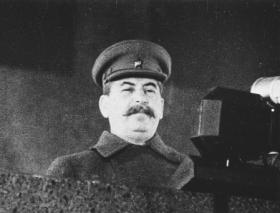
Stalin’s decision to remain in Moscow helped to steady a panic that was developing in the city, and he gave some stirring patriotic speeches to troops on their way to the front, such as here in Red Square, 7 November 1941. (David King Collection)
The German invasion plan envisaged a quick and easy war in Russia that would see the Red Army destroyed within a few weeks and the country occupied along a line running from Archangel in the north to Astrakhan in the south. Thanks in part to Stalin’s miscalculations about the timing and immediate consequences of a German attack, Hitler almost achieved these goals. (See map, p. 44.) Only when the Red Army repelled a German attack on Moscow in November–December 1941 did the tide of war begin to turn in the Soviets’ favour. Even so, Hitler was strong enough to attempt victory again in 1942, this time in a southern campaign that took his armies to Stalingrad.
After his death Stalin came under attack in the Soviet Union for allowing himself to be so surprised by Hitler. Leading the assault was Nikita Khrushchev, his successor as Soviet leader. In a secret speech to the twentieth congress of the Soviet Communist Party in 1956 Khrushchev denounced many aspects of Stalin’s leadership, including his warlordship. According to Khrushchev, it was clear that the Germans were going to invade and that the invasion would have disastrous consequences for the Soviet Union if the country was not adequately prepared and mobilised. When war broke out, claimed Khrushchev, Stalin went into a state of shock and did not come to his senses until other party leaders went to him and insisted that he continue to lead the country. Stalin recovered his nerve but his amateurish military leadership proved to be disastrous, argued Khrushchev. Only the sacrifices of the Soviet people saved the country from defeat, and it was Stalin’s generals and his comrades in the party leadership who deserved the credit for victory.
Khrushchev’s somewhat self-serving critique of Stalin’s war leadership was part of a more general effort by him to puncture the mythology generated by the cult of personality that surrounded the dictator until his death in 1953. According to the personality cult, Stalin was a military genius who could do no wrong. Soviet defeats in the early years of the war were explained as part of the great Stalin’s plan to draw the Germans deep into Russia in order to annihilate them, while Soviet victories were all designed and directed by the dictator himself.
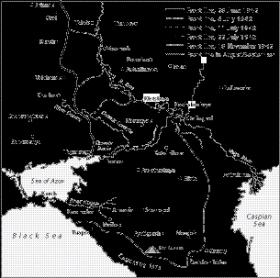
The German advance in the south, summer 1942.
But when Khrushchev fell from power in 1964 a different view of Stalin as warlord began to emerge. Those Soviet generals who had worked closely with Stalin testified to the dictator’s military talents, particularly after he had learned the painful lessons of defeat. According to Zhukov,
‘Stalin made a big personal contribution to the victory over Nazi Germany and its allies. His prestige was exceedingly high, and his appointment as supreme commander was wholeheartedly acclaimed by the people and the troops. To err is human, and, of course, the supreme commander did make mistakes early in the war. But he took them close to heart, gave them deep thought, and sought to draw due lessons from them so as never to repeat them again.’
This more positive view of Stalin’s role as supreme commander has been confirmed by the new evidence from the Russian archives that emerged after the collapse of Soviet communism in 1991. It is clear from Stalin’s appointments diary, for example, that he did not suffer a nervous collapse when the Germans invaded. Stalin was certainly shocked by the extent of the early German successes, but he remained in control and maintained the coherence of his military and political command structure in the face of devastating defeats. Even when the Germans were approaching Moscow Stalin did not waver and took some key decisions that helped to save the city. Zhukov was given command of Soviet defences and Stalin resisted the temptation to throw all his reserves into the defensive battle, saving some for a planned counter-offensive. His decision to remain in Moscow helped to steady a panic that was developing in the city, and he gave some stirring patriotic speeches to troops on their way to the front.
Khrushchev’s criticism that Stalin always preferred offensive action and had little time for defence was more valid. When the Germans attacked in June 1941 he ordered a series of massive counter-offensives that made little headway but further disorganised Soviet defences. Against the advice of his generals, he refused to withdraw his forces from Kiev, the Ukrainian capital. The result was that four Soviet armies—more than 40 divisions—were encircled by the Germans and 600,000 Soviet soldiers were killed, captured or went missing in action. After Zhukov’s repulse of the Germans in front of Moscow in December 1941, Stalin ordered a general counter-offensive with the aim of executing an Operation Barbarossa in reverse—of driving the Wehrmacht out of Russia within months, if not weeks. This first great winter offensive of the Red Army secured some initial gains but ran out of steam by early 1942 and the scene was set for a German comeback later that summer.
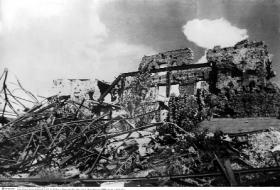
Ruins of the factory district in besieged Stalingrad. One of the keys to success was maintaining a Red Army bridgehead in Stalingrad itself that would keep the Germans locked into a gruelling war of attrition for the city. (Interfoto)
But it wasn’t just Stalin who was gung-ho for offensive action. The offensivist orientation was integral to the Red Army’s military culture, and it was a doctrine to which all Stalin’s generals fully subscribed. Most of Stalin’s mistakes during the early years of the Eastern Front war were made on the advice of his generals. They, like him, were on a steep learning curve, and it took time and experience for them to develop better judgement—and the better they got at their job the more willing was Stalin to take their advice.
Victory at Stalingrad
The great turning-point for Stalin and his generals came during the battle of Stalingrad. In summer 1942 the Germans re-launched their invasion of the USSR with a campaign in southern Russia designed to reach Baku and capture the oilfields that supplied 80% of the Soviet war economy’s fuel. As in summer 1941, the Germans advanced very rapidly and Hitler was encouraged to think that his armies could simultaneously reach Baku and occupy Stalingrad. ‘Stalin’s city’ was a psychological as well as an industrial and strategic target for Hitler, and its capture would have been a devastating blow to Soviet morale. (See map, p. 46.)
Stalin was slow to respond to the German threat in the south because he thought that Hitler’s main target was Moscow. Another problem was that some ill-conceived and badly prepared offensive operations in April–May 1942 had resulted in such severe losses that Soviet defences were in a badly weakened state when the Germans launched their southern campaign. But when Hitler’s intentions became clear, Soviet defences in the Stalingrad area were strengthened and plans laid for a concentrated counter-offensive that would turn back the German advance. One of the keys to success was maintaining a Red Army bridgehead in Stalingrad itself that would keep the Germans locked into a gruelling war of attrition for the city. This was the importance of the prolonged defensive battle of Stalingrad that the Soviets waged from August to November 1942.
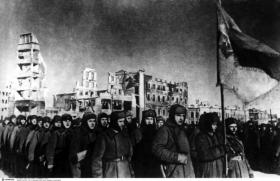
Victorious Soviet soldiers marching through the ruins of Stalingrad. Stalin and his generals had orchestrated a heroic defence of the city that was admired throughout the allied world. (Interfoto)
The turning-point at Stalingrad came in November 1942, when the Soviets launched a multi-pronged offensive that surrounded Hitler’s armies in the city and threatened to cut off German forces advancing toward Baku. In the event the Germans were able to execute a retreat that saved some of their southern armies, but their troops in Stalingrad remained trapped in the city and by early 1943 had either been wiped out or captured by the Red Army. When the dust had settled, the Germans and their allies had lost nearly 50 divisions and suffered casualties of one and a half million, including 150,000 dead in Stalingrad alone. Hitler’s southern campaign was a complete failure, and the last real chance for the Germans to win the war on the Eastern Front had been lost. (See map, p. 47.)
Stalingrad was a triumph for Stalin and his generals. They had orchestrated a heroic defence of the city that was admired throughout the allied world, and demonstrated consummate operational art in the skilful execution of a complex strategic encirclement operation. During the course of these operations the Soviet high command developed a coherence and dynamism that it maintained until the end of the war. Central to this cohesion and creativity was Stalin’s leadership. It was his authority and his handling of relations with and between his generals that united and energised the group. Stalin continued to make mistakes—as did his generals—but these became fewer and less costly as the war progressed. After Stalingrad, German defeat on the Eastern Front was inevitable—as long as the Soviet people continued to make colossal sacrifices and providing that Stalin and his generals kept on winning the big battles.
The verdict on Stalin
In an interview published in 1981 Averell Harriman, US ambassador in Moscow during the war, who had more direct dealings with Stalin than almost any other foreigner, summed up the dictator’s qualities as a warlord:
‘Stalin the war leader was popular, and there can be no doubt that he was the one who held the Soviet Union together. I do not think anyone else could have done it. I’d like to emphasise my great admiration for Stalin the national leader in an emergency—one of those historic occasions when one man made such a difference. He had an enormous ability to absorb detail and to act on detail. He was very much alert to the needs of the whole war machine. These were not the characteristics of a bureaucrat, but rather those of an extremely able and vigorous war leader.’
Richard Overy’s verdict in his classic book Why the Allies won (1975) was that
‘Stalin brought a powerful will to bear on the Soviet war effort that motivated those around him and directed their energies. In the process he expected and got exceptional sacrifices from his besieged people . . . revelations of the brutality of the wartime regime should not blind us to the fact that Stalin’s grip on the Soviet Union may have helped more than it hindered the pursuit of victory.’
In my book Stalin’s wars I take this argument a step further and argue that Stalin’s war leadership was indispensable to the Soviet victory and that without his personal contribution the war against Hitler may well have been lost. This is a controversial view and the debate about the merits and demerits of Stalin as a warlord continues, but the new evidence from Russian archives means that this discussion is now much better informed. The fall of communism and the end of the Cold War have also facilitated the development of a more detached view of Stalin’s war record—one that recognises that a terrible dictator can also be a great warlord and one who, ironically perhaps, helped save the world for democracy.
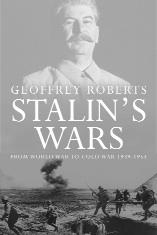 Geoffrey Roberts is Professor of History and International Relations at University College Cork.
Geoffrey Roberts is Professor of History and International Relations at University College Cork.
Further reading:
C. Bellamy, Absolute war: Soviet Russia in the Second World War (Basingstoke, 2007).
D. Glantz and J. House, When titans clashed: how the Red Army stopped Hitler (Kansas, 1995).
E. Mawdsley, Thunder in the east: the Nazi–Soviet war, 1941–1945 (London, 2005).
G. Roberts, Stalin’s wars: from World War to Cold War, 1939–1953 (Yale, 2006).
















